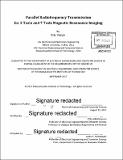Parallel radiofrequency transmission for 3 Tesla and 7 Tesla magnetic resonance imaging
Author(s)
Yetişir, Filiz
DownloadFull printable version (19.58Mb)
Other Contributors
Massachusetts Institute of Technology. Department of Electrical Engineering and Computer Science.
Advisor
Elfar Adalsteinsson.
Terms of use
Metadata
Show full item recordAbstract
Magnetic resonance imaging (MRI) is a noninvasive imaging technique with high soft tissue contrast. MR scanners are characterized by their main magnetic field strength. Commercially available clinical MR scanners commonly have main field strengths of 1.5 and 3 Tesla. Researchers increasingly explore clinical benefits of higher field strength scanners as they provide higher signal to noise ratio and higher resolution images. On the other hand, higher field strength imaging comes with increased image shading leading to non-uniform image contrast. Moreover, the tissue heating rate due to radiofrequency (RF) energy deposition (also called specific absorption rate or SAR) increases, limiting the imaging speed. Parallel RF transmission (pTx) was proposed to address both of these challenges by optimization of RF pulses transmitted from multiple independent channels simultaneously. However, both the RF pulse design and RF safety management become more complicated with pTx. In this work, a framework to apply pTx to 3T fetal and 7T brain imaging is developed to address the image shading and high SAR issues. Fetal imaging where a large pregnant torso is imaged rapidly to avoid fetal motion artifacts, suffers from similar levels of image shading and imaging limitations by SAR to 7T brain MRI. Hence the same techniques benefit both application domains. First, a SAR constrained pTx RF pulse design technique is developed for slice selective high flip angle imaging which is clinically the most common imaging technique. Next, the performance of the developed technique in reducing SAR and the image contrast non-uniformity is demonstrated through simulations and in phantom experiments for 7T brain imaging. Then, a comprehensive RF safety workflow for an 8 channel pTx system at 7T is developed. Finally, the potential of pTx for fetal imaging at 3T is demonstrated with simulation studies and a protected fetus mode of pTx was created using additional constraints in the RF pulse design. By addressing the two main RF transmission challenges associated with high and ultrahigh field MRI, this work aims to help bring the benefits of 7T brain imaging into routine clinical use and significantly improve the clinical experience for 3T fetal imaging.
Description
Thesis: Ph. D., Massachusetts Institute of Technology, Department of Electrical Engineering and Computer Science, 2017. Cataloged from PDF version of thesis. Includes bibliographical references (pages 141-146).
Date issued
2017Department
Massachusetts Institute of Technology. Department of Electrical Engineering and Computer SciencePublisher
Massachusetts Institute of Technology
Keywords
Electrical Engineering and Computer Science.